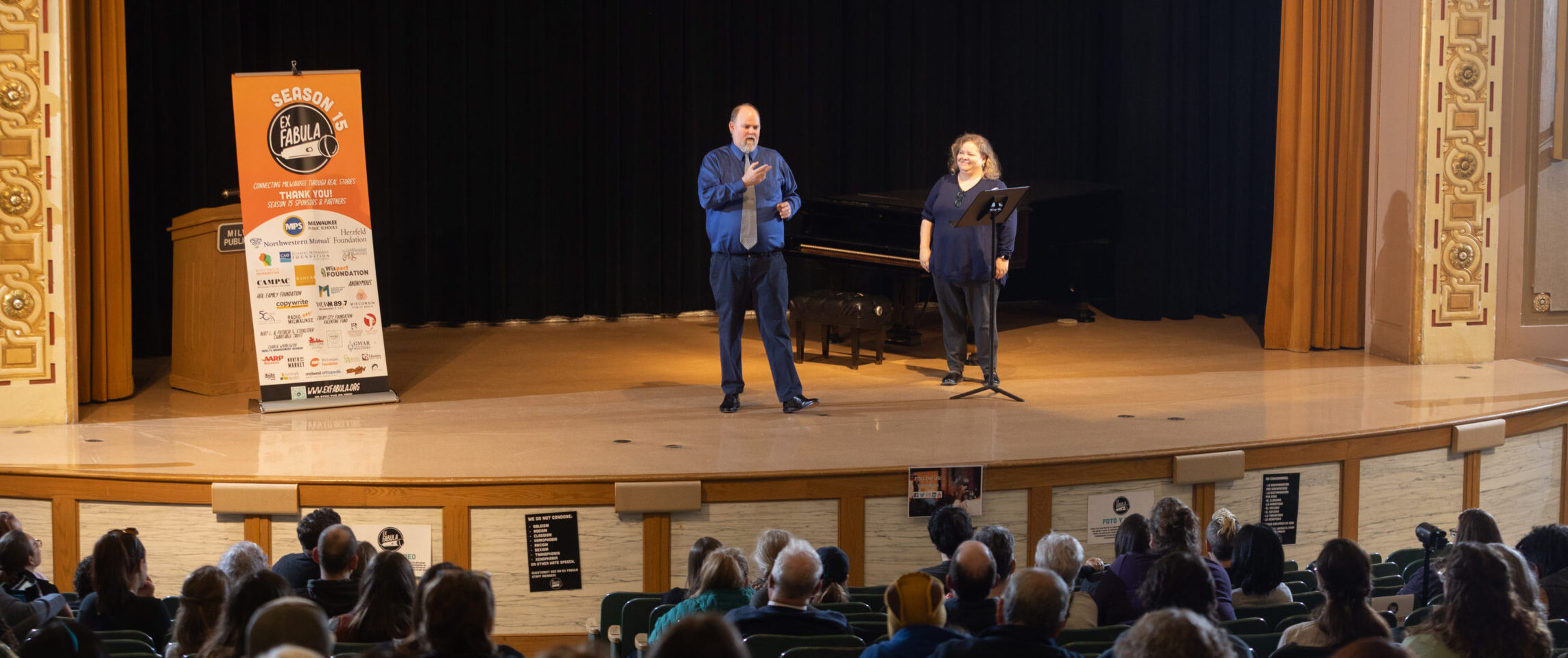Milwaukee Public Library’s Centennial Hall was the venue for the event. When I entered the auditorium, I saw about 50 people divided into several groups. Conversations were taking place, but the room was quiet. Many attendees were members of the Deaf community and using American Sign Language (ASL) to communicate, their fingers flying. For a moment I felt like an outsider and realized that was probably a familiar feeling for those who are deaf when they are alongside members of the hearing community.
By the time the event began there were at least 100 people in attendance. Brian Peters was our convivial host along with the warm and welcoming, Lani Kaplan. Brian signs using both hands, which is uncommon and fascinating to watch. He and Lani both got the audience amped up for a night of storytelling.
All stories were told in sign language and translated by two accomplished ASL interpreters.
ASL has different sentence structures and syntax than speech, which makes translation tricky. Interpreters need to be able to think “on the fly.”
Brian reminded the audience to applaud the tellers by waving their hands in the air so they could “see” our appreciation!
- Joel Mankowski
Joel attended Gallaudet University (the world’s foremost higher ed institute for Deaf and hard of hearing people). He struggled most mornings to get to an early class. His grade partly depended on attendance and punctuality… and despite his best efforts, he was late for the last one. Back in his dorm room, he looked at his clock. He’d set it for 7 p.m. not 7 a.m. User error. The audience nodded in unison. Who couldn’t relate to this common mistake?
- Alison Urdahl
Alyson, an enthusiastic fan of Ex Fabula shared a remarkable story about a Peace Corps experience she had during an interaction with a Deaf girl in Ecuador.
The 12-yr-old girl hadn’t had access to education or any Deaf role models; she had extreme language deprivation. So, to get people’s attention, she would throw stones!
The crux of the story came full circle when someone threw stones to get the girl’s attention. A powerful, if somewhat extreme example of how important human connection and communication truly are.
- Ash Radonski
Ash, a creative writer, shared a dream they had during an extremely stressful time.
Ash shared the specifics of the dream; the audience was pulled into a surreal experience. The dream took place in a bizarre theme park where water slides and hovercrafts coexisted. And although Ash was told repeatedly that they couldn’t go in or participate, they persevered. Their message to the audience: don’t let others define you or box you in.
- Lani Kaplan
Lani’s storytelling was totally engaging. Her facial expressions of irritation and enthusiasm as well as eyerolls “spoke” volumes. And the translator’s playful inflections were a perfect fit for Lani’s story.
Eating in restaurants with her family, who are all hearing is frustrating for her. Surprising to me, not one of them is proficient in ASL, which often meant she was alone even when in their company.
Annoyed with being excluded, Lani showed how oblivious they were to her plight. When they ignored her, she pulled out a book and started reading! Unfortunately, this clever method worked only temporarily.
By contrast, Lani’s experience eating with her Deaf friends is a joy. Even though there’s always mix-ups with the orders, a good time is had by all!
- Jill Stark
Jill’s story was the most dramatic of the evening: her small school bus was involved in a serious accident. Besides being disoriented and scared, at the hospital she learned that she had injuries to her mouth and her jaw was shattered.
Jill’s recovery was long and her scars permanent. While finishing her story, Jill needed a moment to compose herself, the trauma obviously still with her. Her simple yet vital message: “Please STOP for buses.”
- Karen Smith
Karen, a Milwaukee Public School psychologist for 40 years, relished her time at Gallaudet University. The class ring she bought at graduation meant the world to her.
Years later when Karen lost this meaningful memento, she was heartbroken. One day a package arrived in the with a note that said: “Dear Karen, someone found your ring and sent it here to Gallaudet, and we are happy to return it to you.” The ring was a little battered, no longer perfect, but a perfect fit. “I’ll never wear it again; I don’t want to lose it,” Karen said.
- Aysia Vang
Aysia is hard of hearing and went to regular schools until college at Gallaudet. While there she connected profoundly with three people. Each person was in a crisis, physical and/or emotional. She was compelled to help them to the best of her ability.
After the third unsettling experience, Aysia grasped an important life lesson: don’t be a bystander. It’s crucial to be present and help others when you can, whether they are friends or strangers.
Thanks Ex Fabula. It was a privilege to be a part of this entertaining and illuminating event.






Leave A Comment